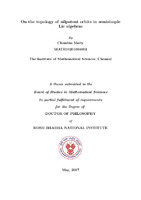- DSpace Home
- →
- IMSc Theses/ Dissertations
- →
- IMSc Theses/ Dissertations
- →
- View Item
JavaScript is disabled for your browser. Some features of this site may not work without it.
| dc.contributor.author | Chandan Maity | |
| dc.date.accessioned | 2017-08-07T09:29:59Z | |
| dc.date.available | 2017-08-07T09:29:59Z | |
| dc.date.issued | 2017 | |
| dc.date.submitted | 2017 | |
| dc.identifier.uri | https://dspace.imsc.res.in/xmlui/handle/123456789/407 | |
| dc.description.abstract | The nilpotent orbits in the semisimple Lie algebras, under the adjoint action of the associated semisimple Lie groups, form a rich class of homogeneous spaces. Such orbits are studied at the interface of several disciplines in mathematics such as Lie theory, symplectic geometry, representation theory, algebraic geometry. In this thesis we contribute by studying two specific topological invariants, namely the second and the first de Rham cohomology groups, of such orbits in non-compact, non-complex simple Lie algebras. To put our work in proper perspective we first recall that all orbits in a semisimple Lie algebra under the adjoint action are equipped with the Kostant-Kirillov two form. Using involved computations we describe the second cohomology groups of the nilpotent orbits in real classical Lie algebras which are non-complex and non-compact. We also compute the second cohomology groups of the nilpotent orbits for most of the nilpotent orbits in real simple non-compact non-complex exceptional Lie algebras, and for the rest of cases of the nilpotent orbits, which are not covered in the above computations, upper bounds for the dimensions of the second cohomology groups are obtained. A key components in the computation is a conveniant description of the second cohomology groups of homogeneous space of a connected Lie group. On the other hand, in view of their applicability the above results may be of independent interest as they are general and hold under a very mild restriction. We deduce stronger consequences of the above results in the special cases when the ambient Lie groups are complex semisimple or real simple. We next briefly mention the strategy in our computations. As a preparatory step, we apply the above results to derive the descriptions of the second and the first cohomology groups of nilpotent orbits in simple Lie algebras. This result, which is key to our computations of the second and first cohomology groups of the nilpotent orbits, describes the second and the first cohomology groups of the nilpotent orbits in simple Lie algebras in terms of a maximal compact subgroup of the centralizer of a sl_ 2 ( R )-triple containing the nilpotent element and a maximal compact subgroup of the associated ambient Lie group containing the former one. As an interesting consequence, it follows that the first cohomology group of any nilpotent orbit in a simple Lie algebra is at the most one dimensional. Thus, in view of the above result, the main goals in our computations of the second cohomology groups of the nilpotent orbits in real classical non-complex non-compact Lie algebras are to obtain the descriptions of how certain suitable maximal compact subgroups in the centralizers of the nilpotent elements are embedded in certain explicit maximal compact subgroups of the ambient simple Lie groups and how the component group acts on certain subalgebra of the center of the maximal compact subalgebra of the centralizer of the nilpotent element. | en_US |
| dc.publisher.publisher | The Institute of Mathematical Sciences | |
| dc.subject | Nilpotent Orbits | en_US |
| dc.subject | Parametrization | en_US |
| dc.subject | Cohomology | en_US |
| dc.subject | HBNI Th121 | en_US |
| dc.title | On the Topology of Nilpotent Orbits in SemiSimple Lie Algebras[HBNI Th121] | en_US |
| dc.type.degree | Ph.D | en_US |
| dc.type.institution | HBNI | en_US |
| dc.description.advisor | Pralay Chatterjee | |
| dc.description.pages | 222p. | en_US |
| dc.type.mainsub | Mathematics | en_US |
| dc.type.hbnibos | Mathematical Sciences |
Files in this item
This item appears in the following Collection(s)
-
IMSc Theses/ Dissertations
IMSc Theses/ Dissertations
